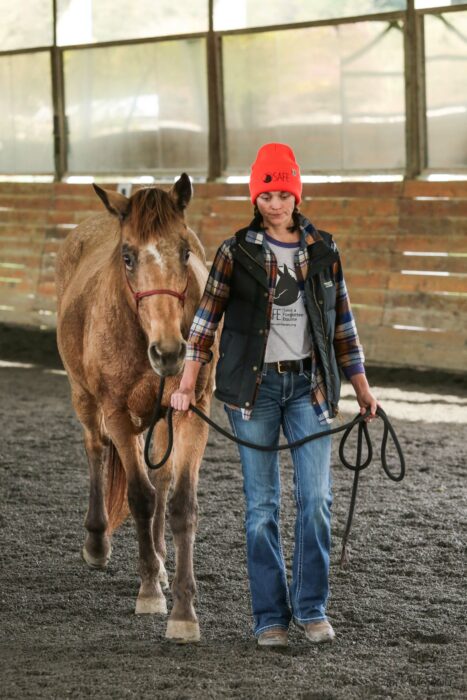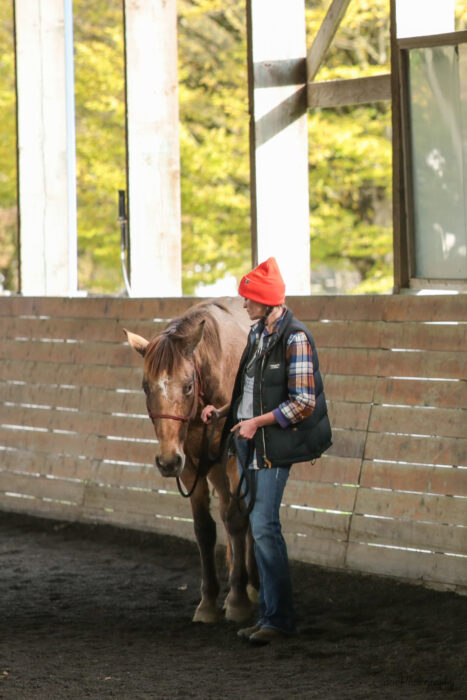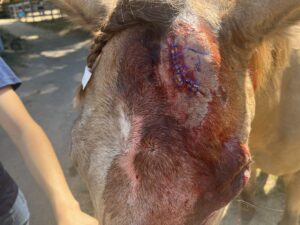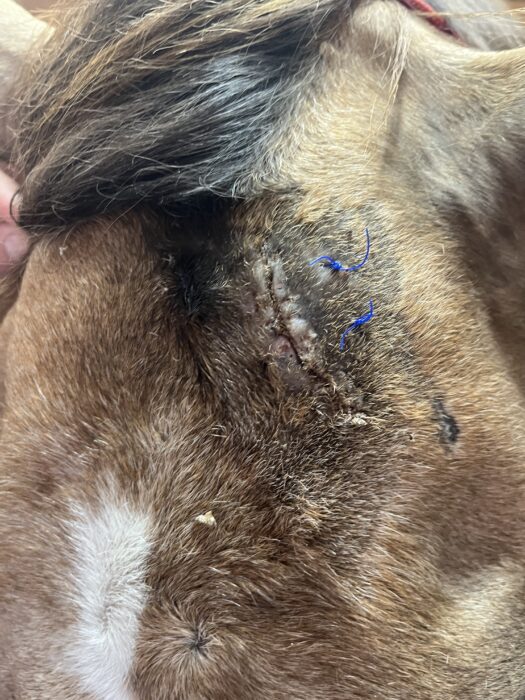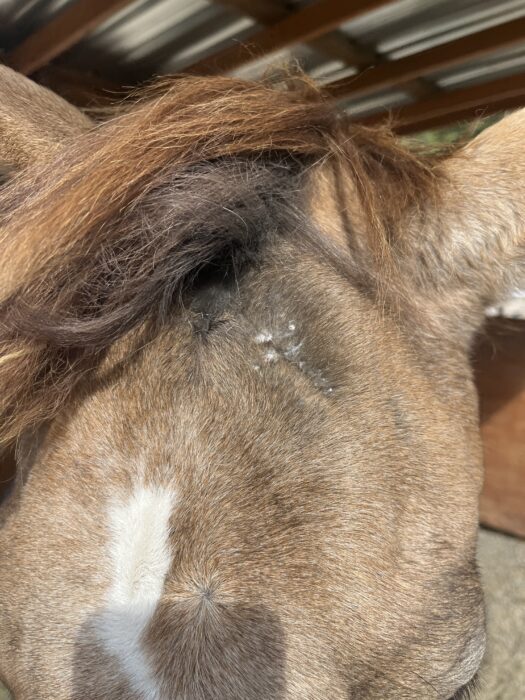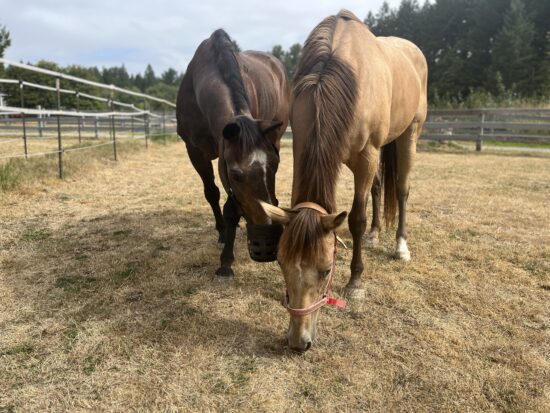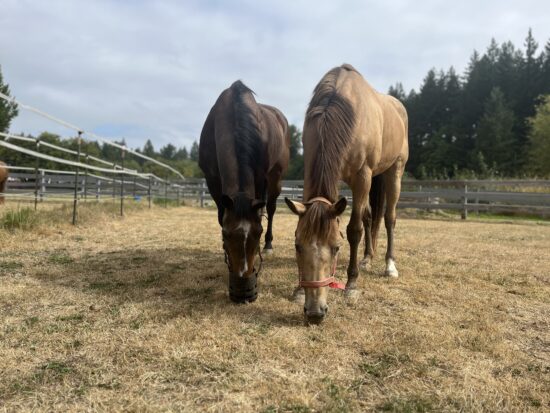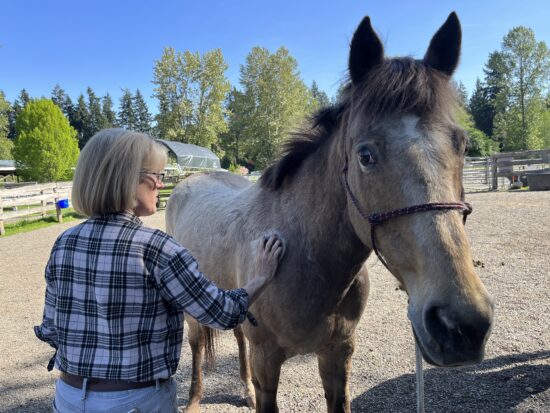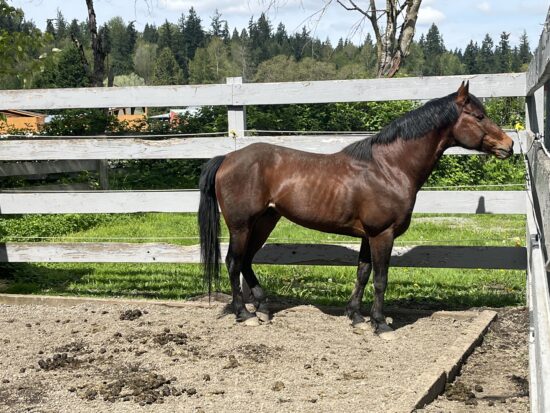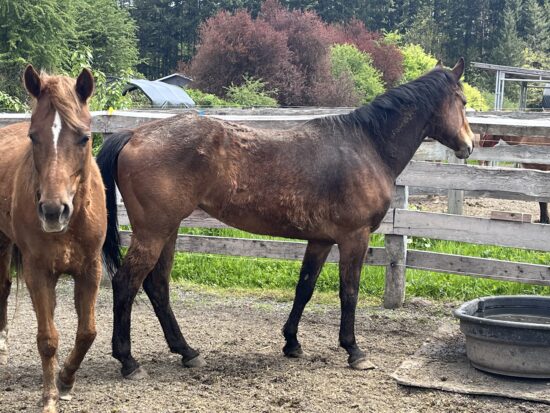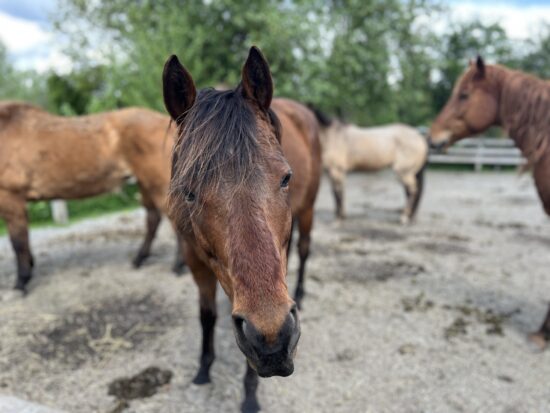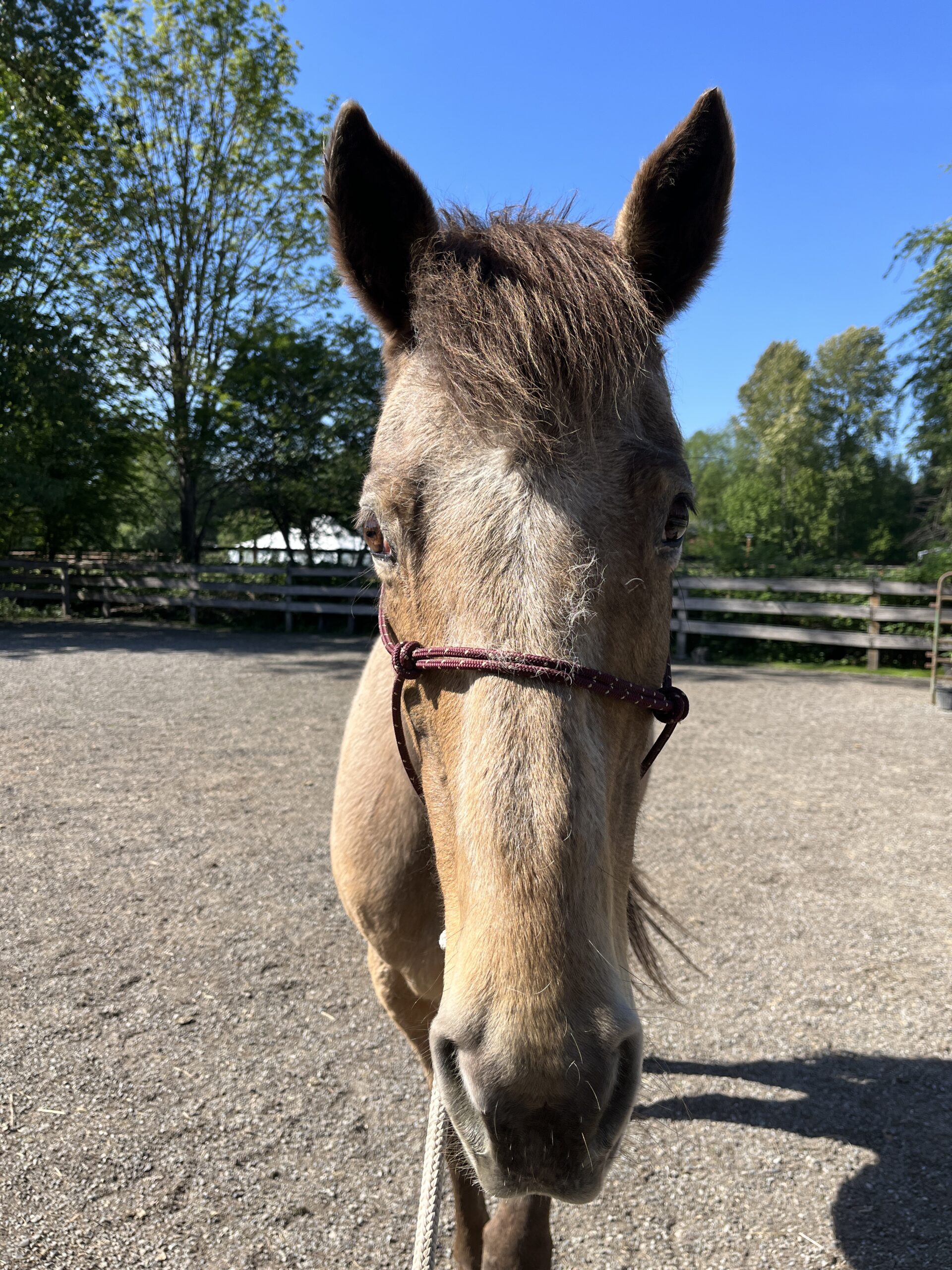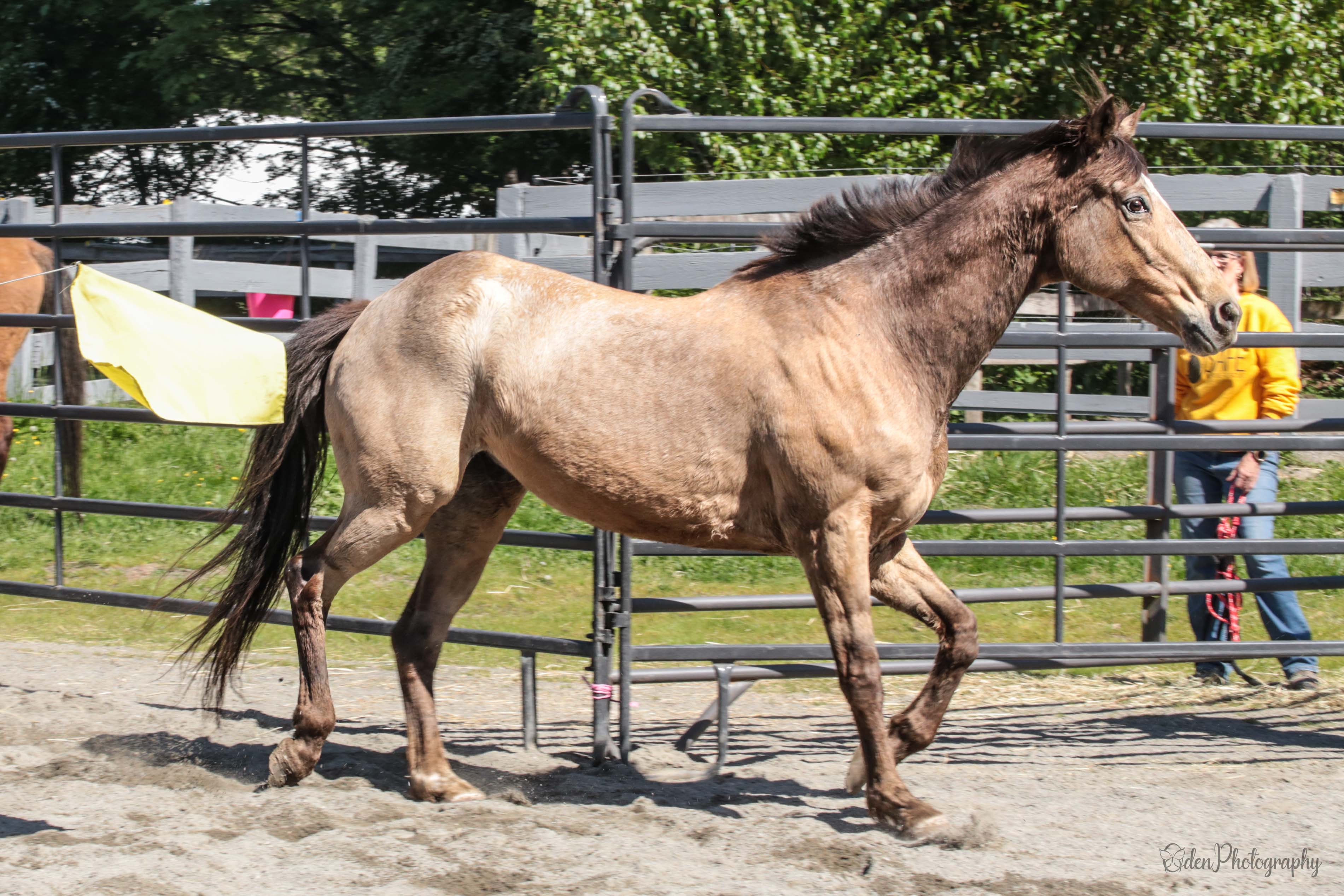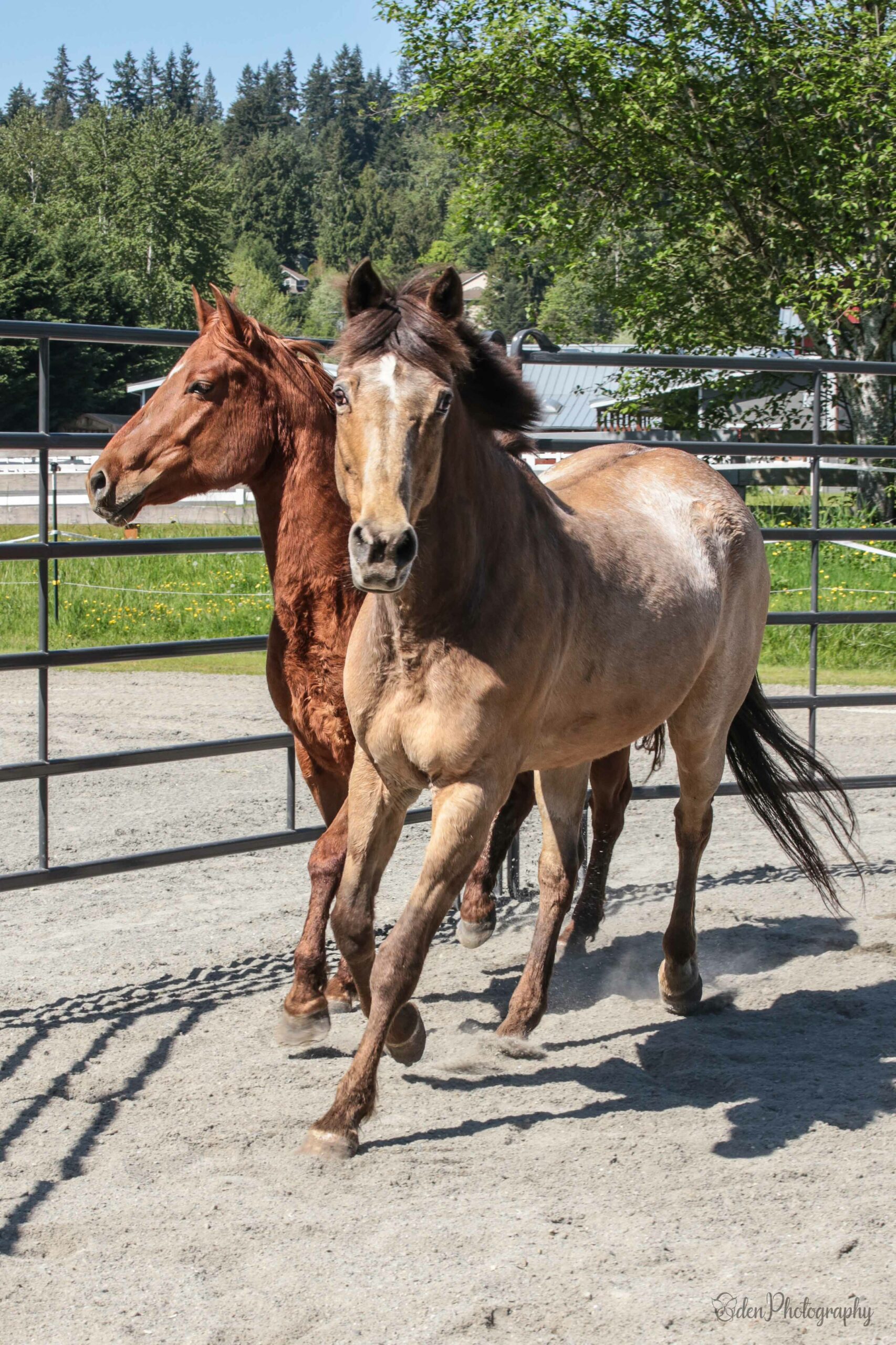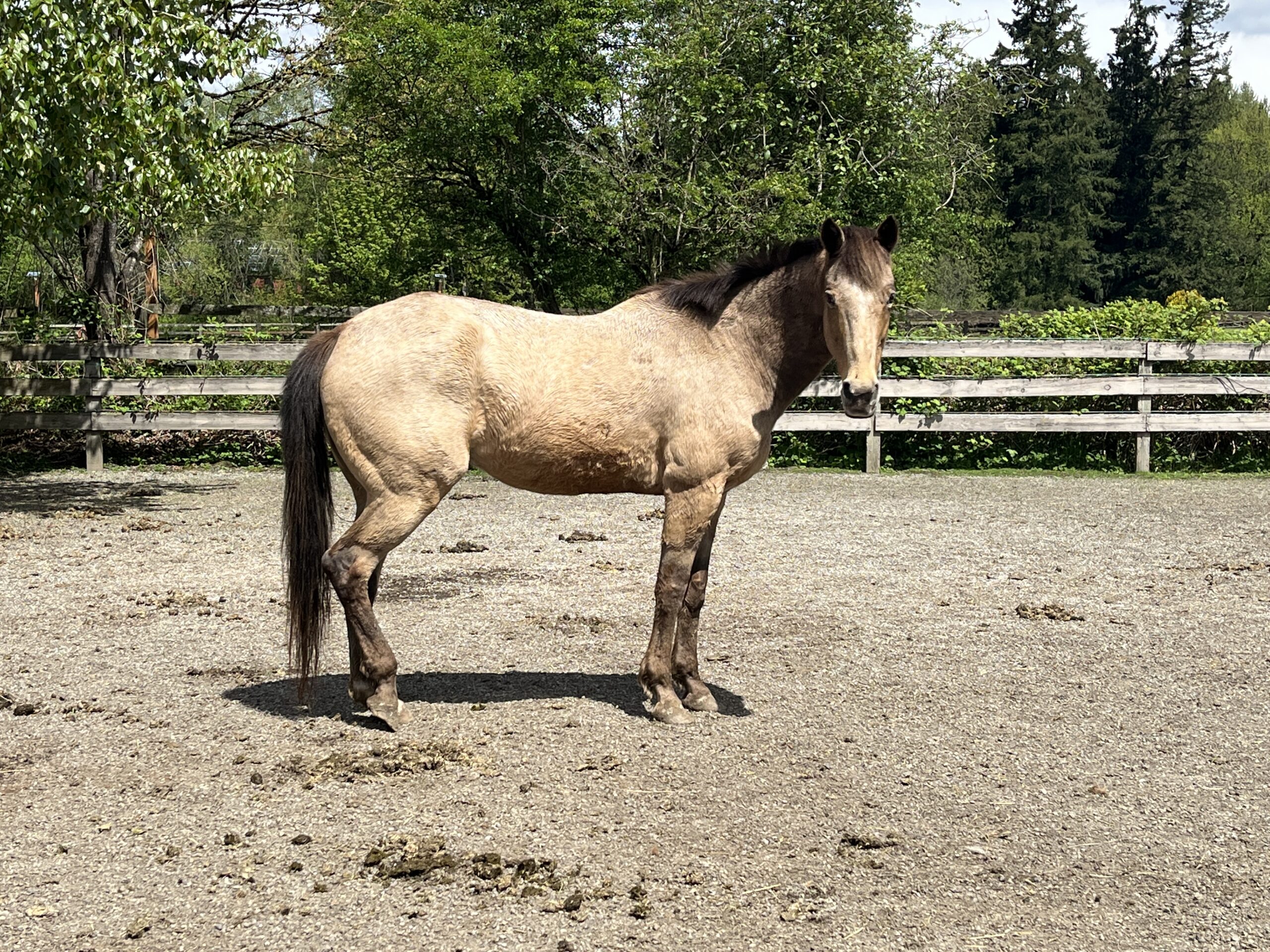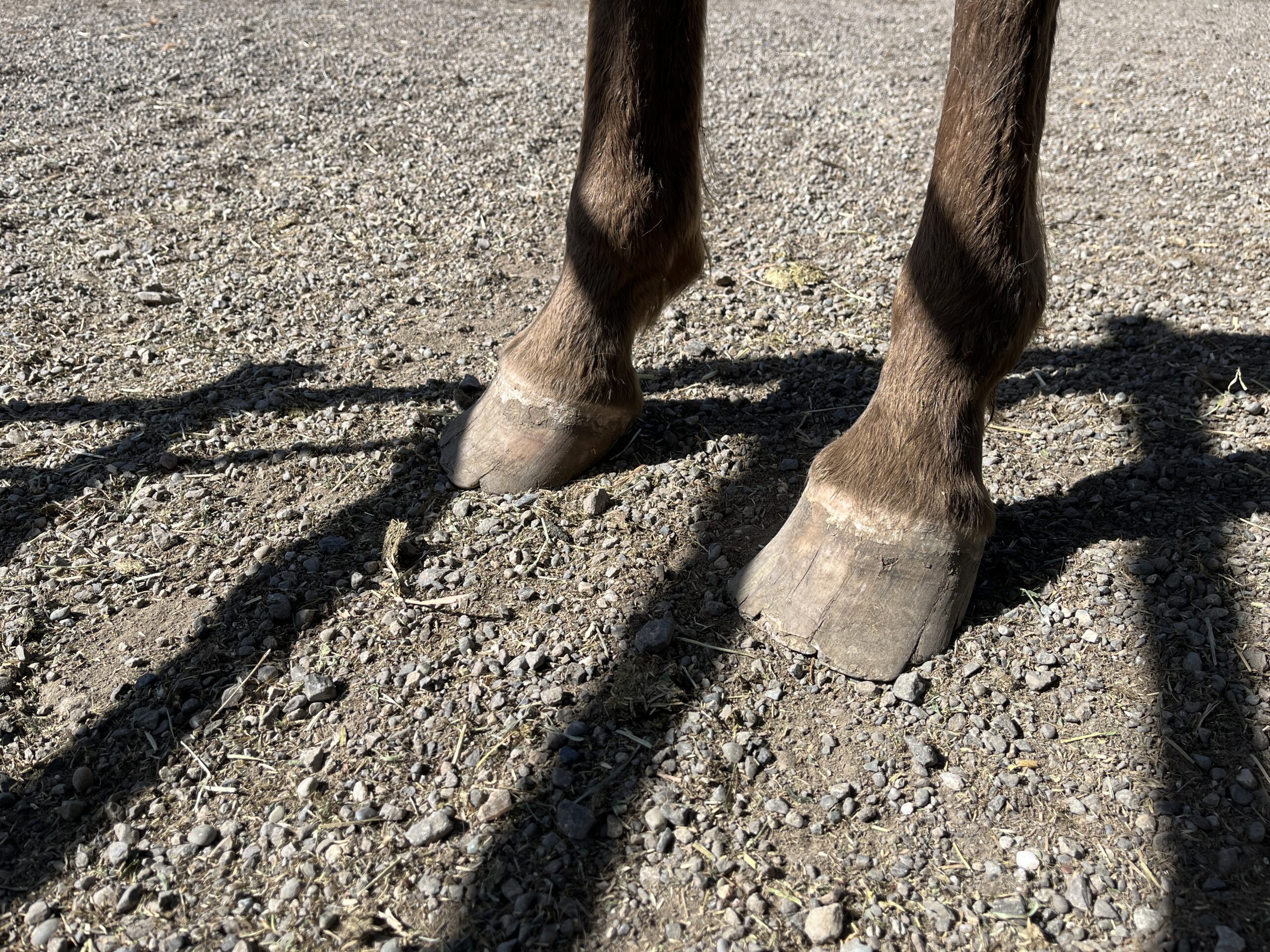Mirana
Quarter Horse mare
Suitability: Companion, For Intermediate Handler
Color: buckskin
Markings: blaze
Height: 14.3h
Weight: 816lbs
Adoption Fee: $300
Mirana is one of the oldest of the group, and likely has some vision impairment, the extent of which we will get a better idea of when she is seen by the vet. Although she was one of the only horses we were able to get a halter on, Mirana arrived at SAFE far from gentle. She was very herdbound to her fellow pasture mates, and was not afraid to steamroll over people to get to them.
But horses have a tremendous capacity for change, and we believe that with a good deal of patience and consistency, Mirana can be made as gentle as the best of them. As it is with all the horses here at SAFE, we will give her as much time as she needs.
All SAFE horses are adopted with a no-breeding clause, no exceptions.
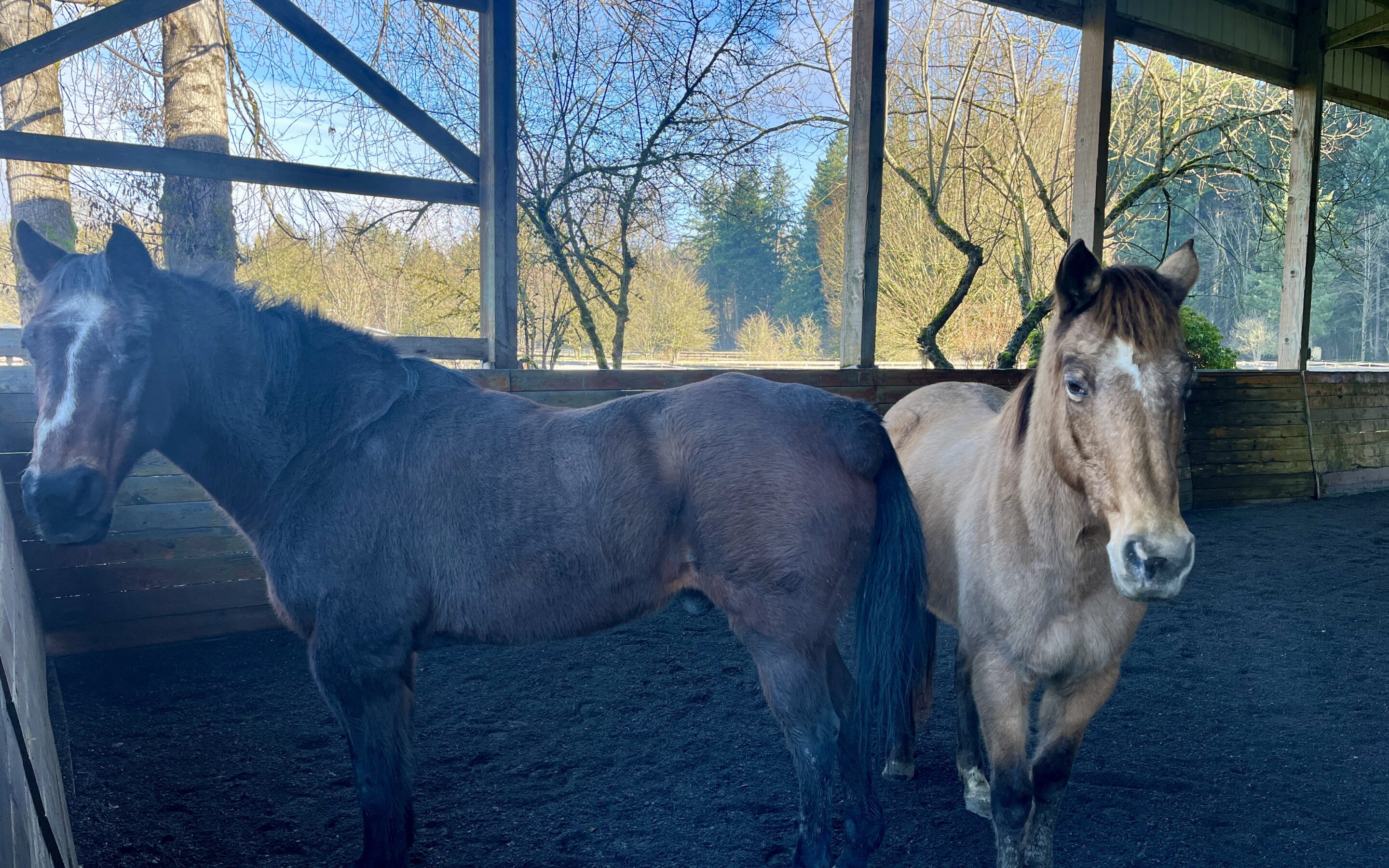
Roy and Mirana’s Arena Time
When we close our pastures for the winter, we switch instead to arena turnout for those horses not in a larger herd paddock. While there may not be grass to much on, the arena has its own list of pleasures, including soft dry sand and a wide open space to run amok in. Roy and Mirana met over grass last summer, and have been neighbor buddies since then (Roy’s grain-only feed situation makes it hard to turn him out to cohabitate with others). But what he can do is enjoy some good arena turnout with his friend Mirana, who also very much enjoys her arena time with Roy. The two walk respectfully to the arena, but as soon as they are let loose, they Let Loose! Roy, for whom arthritic knees and poor feet are constant unwanted companions, kicks up his heels with the best of them when let off the line. And Mirana looks like a filly again as she lopes around the arena. The two typically have a very set schedule when it comes to arena turnout, and it goes something like this:
Stand respectfully while the halter is taken off, but as soon as the humans have fully released, launch out of dodge!
Find a good spot to roll IMMEDIATELY. Extremely crucial step.
Commence rolling. Bonus points if you make it all the way over, but no one’s judging. If you’re Roy: spend a little time itching your belly.
Get up, time to RUN! This can be a long run or a short run, but the burst of energy is highly necessary.
Go stand on the far side of the arena to nap in the sun (if sunny) or just check out what’s goin’ on over there.
Voila! Recipe for successful turnout time!
Watch for yourself these two in action:
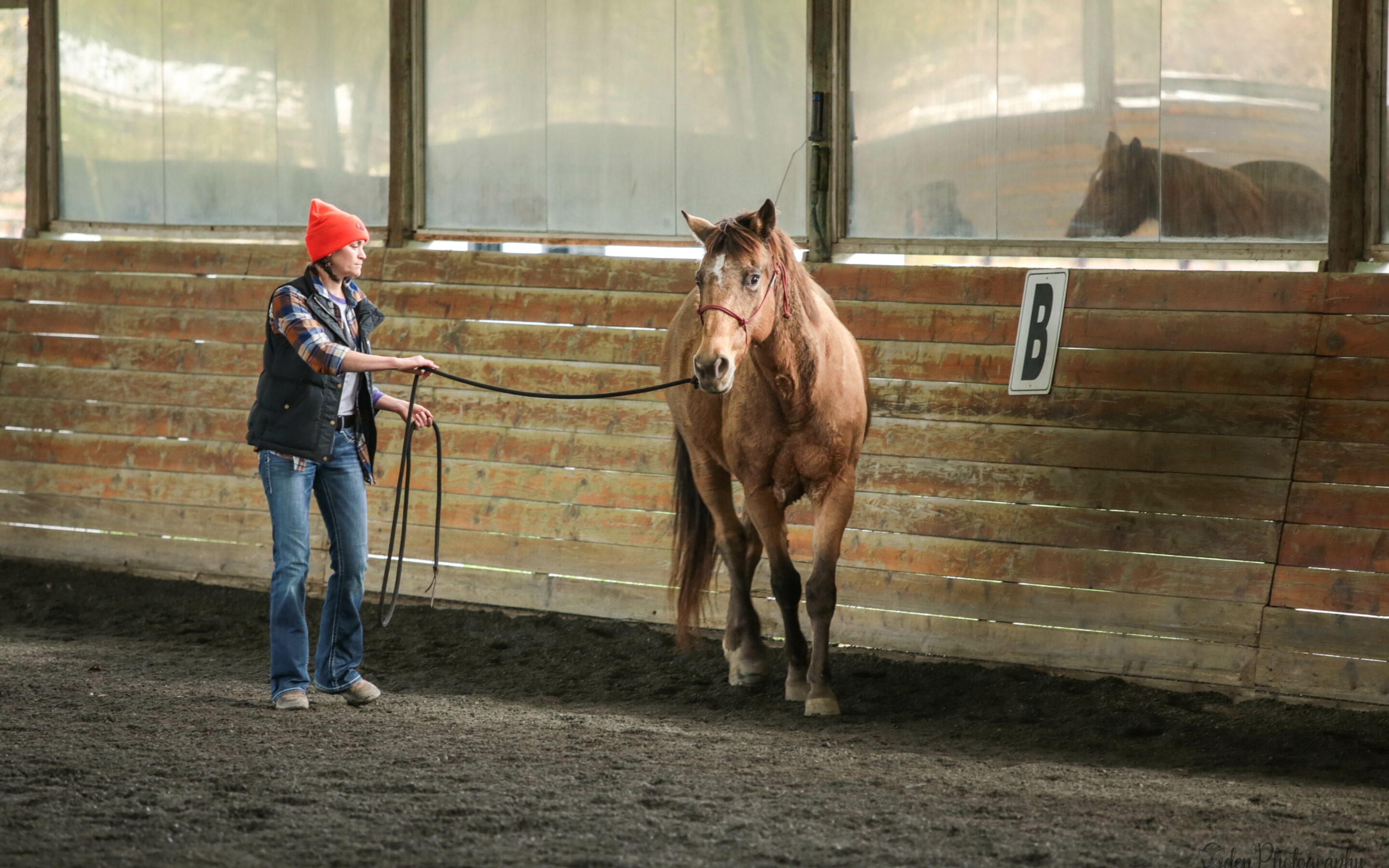
November Clinic Report: Mirana
Meghan N worked with Mirana in the November Joel Conner clinic, and reflects on the experience below:
“Mirana’s Learning Adventure Continues
Mirana participated in her second Joel Conner Clinic this past weekend. This mare is smart, but has some troubles to work through so she can be comfortable and confident in herself and her ability to have freedom in her feet. One challenge we began to work on, is helping Mirana understand that she can stand and have peace.
During the clinic there are many moments where we are watching and learning; but Mirana struggled to just enjoy the breaks. She has a challenging time changing eyes, especially turning loose to her right eye so she feels uncomfortable about what may be going on around her. We found that walking on the united circle and practicing hindquarters helped to ease her mind, as she slowly realized that she was free to move and could get away from danger if it were to presented itself. The first day of the clinic, we did this very frequently, with less than a minute of standing before we needed to move. The goal was to move Mirana before she felt the need to walk off. By the last day of the clinic, Mirana started to find some peace, and could stand while we watched/learned for close to 5 minutes at a time!
We worked a lot on hindquarters this clinic, so Mirana could feel confident that she is able to calmly move away and be free from anything that may scare her. As well, we helped to support Mirana in not having her shoulder fall in. She is a sensitive mare who really responds to pressure and release, but when she is feeling vulnerable she needs more support to remind her that she can be balanced and is able to thoughtfully move her feet! The flag was a challenge for Mirana, but with the support of Joel Conner and Kaya Mead, not only did Mirana start to understand that it was not something that would hurt her, she slowly began to accept it’s touch/petting.
Overall, Mirana made some huge strides this weekend! She is starting to learn how to respond and not react to the world around her. She is beginning to understand that she can find balance and confidence in herself; and that she will always be safe in her life, going forward!”
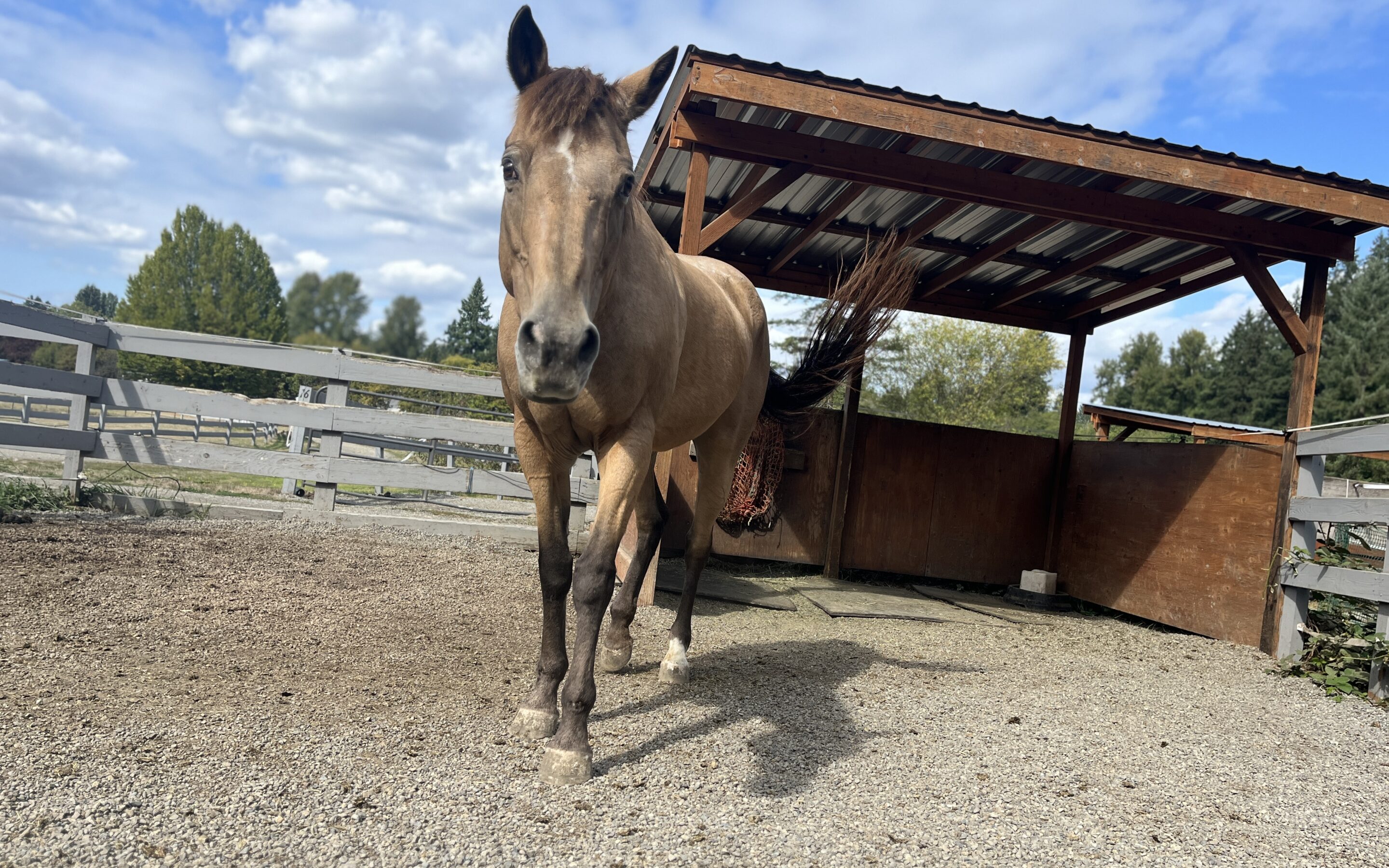
Mirana’s Scrape
When we play ‘musical horses’ at SAFE, shifting paddock assignments around for one reason or another, we make two variations on the traditional rules of the game. The first is that everyone ends up with a spot at the end, and the second is that we typically don’t play music while we shuffle around. So while the lack of a chair pulled out from under them, literally or figuratively, might lead you to believe that this is a low-risk game for our herd, inevitably the disruption changing homes causes can, on occasion, be injurious.
We do our best to give each horse a house-warming gift when they switch locations. Be it a soupy mash or a flake of hay, a distraction is always a nice way to settle in to a new space. But sometimes, change is especially difficult for a horse to come to terms with, and there is little we can do but watch over them as they relax into their home.
Mirana was one such case. Herd bound to her friends, we moved her to get her a change of scenery and a new buddy to go out on grass with. But that initial day was a bit rough for the lady, and in her frantic maneuvering in her new paddock, she ended up crashing her head into the gate. A sudden and unfortunate accident, the exact kind that horses are especially prone to Luckily, we were already on the scene, as we were watching for the potential of something like this — not waiting, not expecting, but ready to take action if action was needed.
The cut was hiding beneath her forelock, which made it hard to see at first, but once we pulled away the curtain, a nice laceration was revealed, about 3″ in length, and definitely full thickness. Full thickness, meaning that each side of the wound moves independently of the other. Such injuries require vet attention, as stitches or another kind of professional aid is in order to help it heal.
We are ever so grateful to have good vets, who were quick on the scene to address Mirana’s head cut. Luckily, in the time after her injury, she managed to calm down somewhat, and we continued to stand by her as we waited for the vet, rinsing her off with the hose and letting her hand-graze a bit. When Dr Lewis arrived, she gave her some sedation, which Mirana stood very well for. Then, she got to work stitching her up. Dr Lewis put in a total of 10 stitches, no small amount! She then gave us a course of antibiotics to give the mare, and instruction to call her back out in a week or two to remove the sutures.
Over those next two weeks, Mirana settled in just fine to her new digs. She didn’t pull any repeat maneuvers that required the vet out, and met her neighbor, Roy, in their shared grass paddock, where the two got along famously from the jump. When the two weeks were up, it just happened to be the same day she was scheduled for a dental (happy coincidence), so out those stitches came. Well, aside from two, which were to be left in for another week or so juuuust to make sure she was fully healed. Dr Lewis also popped in a pair of staples at the widest part of the cut to really pull it all together, so to speak.
Finally, a week later, all was removed from Mirana’s face, leaving her with only the slightest indication anything had happened to begin with. And over the course of those weeks, as we watched Mirana’s cut heal, we also watched as she grew more confident in her surroundings, both in and out of her paddock.
- Before the final stitches were removed
- All healed up!
Accidents and injuries are never fun, and never wanted, but we are so very grateful for our amazing team of vets over at Rainland who are always quick to take the very best care of our herd!
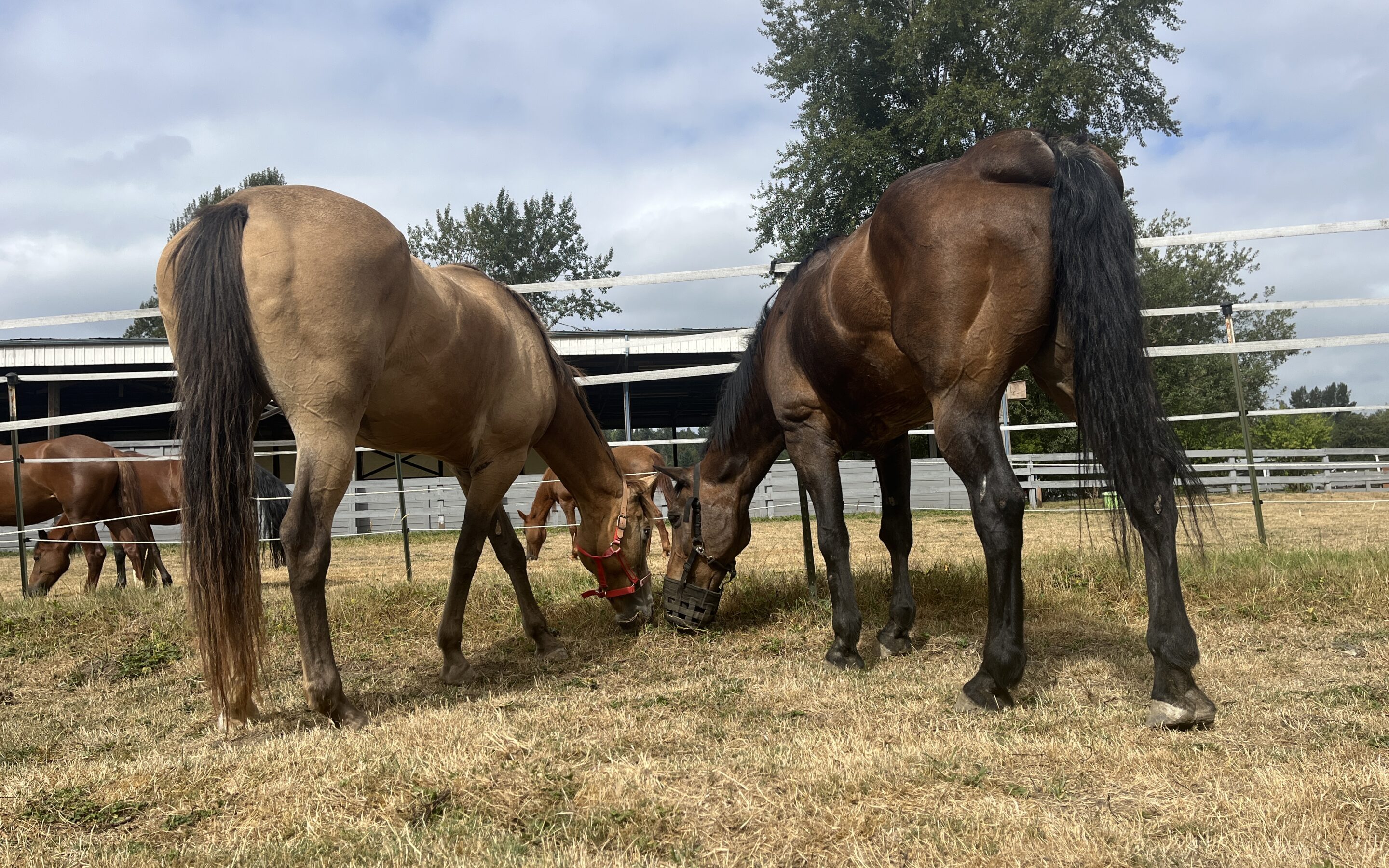
Roy and Mirana, Grazing by a Tree..
If I could add a song to this post, I would probably choose ‘Can You Feel The Love Tonight?’ from a certain loose Hamlet adaptation starring animated lions. It was the first song that sprung to mind when I thought about Roy and Mirana, two horses Of A Certain Age who both were overdue for companionship. While it’s true that no horse at SAFE is ever really alone (even with a double fence line between paddocks, the side yards between horses wouldn’t even be considered a micro-studio by Seattle’s standards), the bachelor pad lifestyle can get old. Unfortunately, there are often roadblocks that get in the way of allowing us to turn out every horse with a buddy.
For a horse like Roy, these roadblocks are numerous.
For starters, Roy is a very tender-footed guy. He has had some hoof events in the past that make his ability to handle anything but the softest of terrains quite ouchy for him. While we explore potential options for his sustained comfort, we have Roy in his own studio apartment of a paddock with soft, cushy sand as flooring. Roy also has bad teeth (if you can even call them that) that makes it risky for him to have access to hay. Roy eats multiple mash meals a day because of this, and a special diet like his means it’s a challenge for him to get turnout with friends.
Apart from his soft sand paddock, the only other footing where Roy is comfortable is on grass. We are able to turn him out this time of year with a grazing muzzle (to add to his list of special needs, Roy also has Cushing’s), and while he does enjoy the time out of his paddock, he would often longingly look towards his neighbors in their herds together.
And then there is Mirana. She had been living in a neighborhood alongside her other cohorts, but it was time for a little restructuring. Mirana’s herdmate, Meadow, had passed away, and Mirana was in need of some company. We moved her across the property, into an empty paddock that just happened to be next to Roy. It was a big change for Mirana, but from across a fence line, Roy did his best to make introductions to his new pretty neighbor. She was not hugely comforted by his presence at the time, but we had a plan.
The next morning, when we turned Roy out in his grass turnout, we put a halter on Mirana as well. It’s nice to make introductions on grass because it adds an element of distraction to an occasionally stressful situation. But we knew Roy had been out with friends in the past, same with Mirana, so we weren’t too concerned when we dropped their halters and let them to their own devices. And what gentle devices they were. There was hardly any reaction whatsoever upon nose sniffing, and the two immediately got to grazing side-by-side, cheek to cheek.
Since that day, the two get together every morning for their daily grass, and when they return to their respective paddocks, they seem comforted by each other, despite the slight separation. It warms our hearts to introduce horses, but especially those who so clearly are seeking companionship.
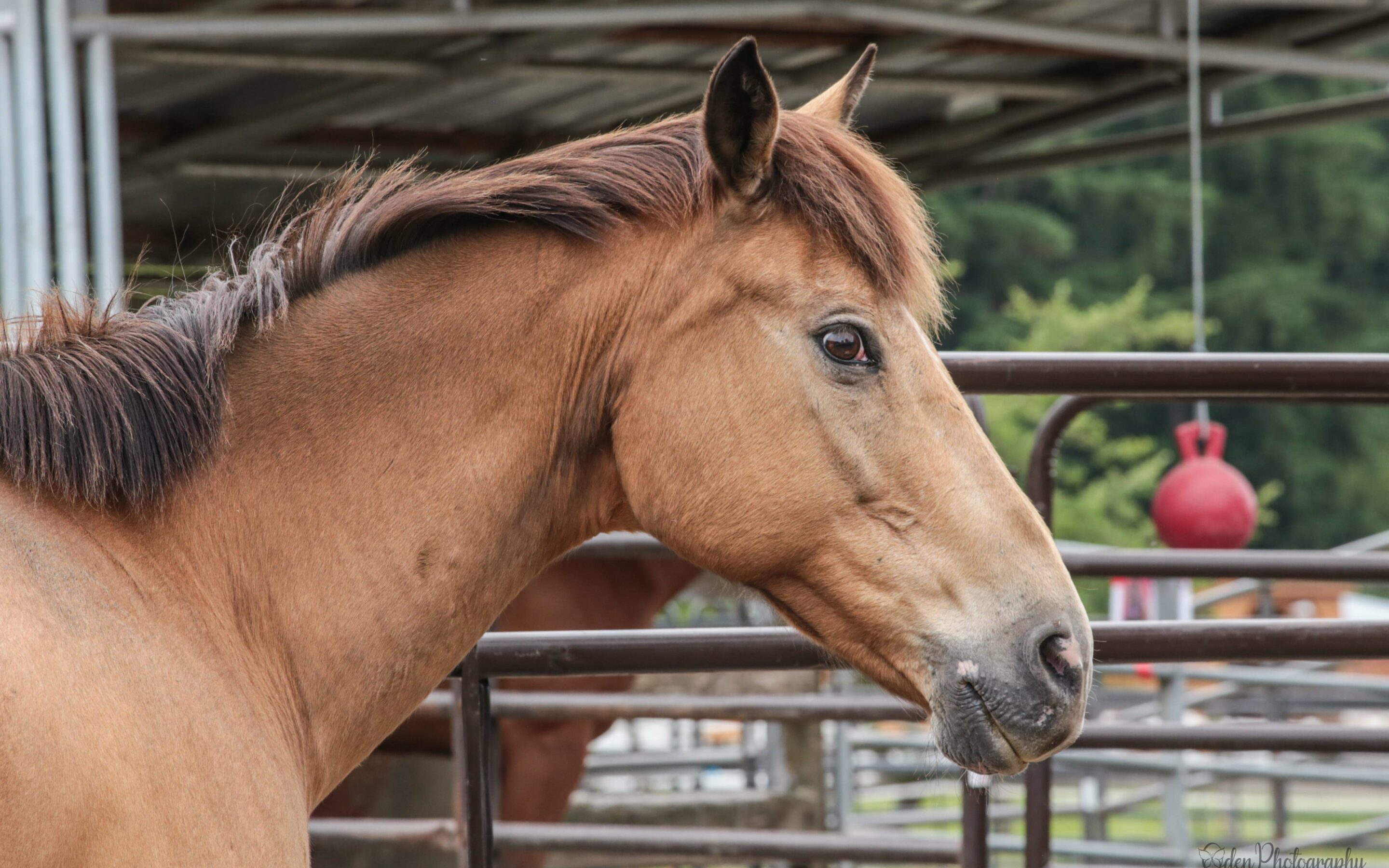
Introducing Mirana
Mirana, along with Meadow, was one of the matriarchs of the Gig Harbor horses we picked up this past May. She was part of the largest herd on the property, a group of four mares living in a scrubby paddock. They, like the others on the property, were lacking in clean water, and their only sources of shelter were buried in thigh-deep mud. Mirana likely had at least ten years on the rest of her cohorts, as well as some vision issues that were immediately made clear to us from the unfocused quality of her eyes. She was gentle enough that we were able to slip a halter on her that first day, luring her close with grain, but it all felt very tenuous.
While it’s true that a lot can be done to shape a horse in a short period of time (for better or worse), it is also true that the more years under their belt that they have, the higher the chance that whatever they learned is calcified pretty strongly. It quickly became clear to us once we unloaded Mirana and met her on our turf, so to speak, that one of the things she had learned from humans was how inconsequential they were. She was very herd bound, and at the slightest suggestion of one of her friends leaving, she became very anxious. In these periods of anxiety, Mirana became a wrecking ball, oblivious to anything in her path, human-shaped things included. She did not look to humans as a source of any sort of comfort, and clearly had not for a long time, possibly ever.
But when she is settled, Mirana has a sweetness about her that is heart-wrenching. She enjoys pets on the face, and likes a good currying on her rain-rot scarred back. And herein begins our journey with Mirana, teaching her the importance of boundaries while also showing her that humans can be kind, and the two are not necessarily mutually exclusive.
Mirana is still uncertain about being caught sometimes, and even though she can be haltered and led, she is not what we would consider to be ‘halter broke.’ She does not know how to come off of pressure very well, and her leading on a line is really only on her terms. So for this mare, likely with at least two decades behind her, we must start from scratch to teach her the very basics in order to ensure her successful future.
We have also been working on gently separating her from her friends, and teaching her that security can come from both herself and her handler. For a horse like Mirana, who can become dangerous to herself and others when separated from her herd mates or a location she knows, it is crucial to teach her this lesson to keep her from hurting herself or someone else. It will also allow us to have her vetted, to introduce her to other parts of the property, and to eventually ready her for a forever home somewhere else.
The going may be slow at times, but there is never a time frame, and we would like to think that despite her 20-odd years, with Mirana’s first steps off the trailer at SAFE, she began the first day of the rest of her life.

Introducing the Gig Harbor 7
The majority of the horses who come to SAFE come as singles or in pairs. One here, one there, typically with some space in between arrivals. But on occasion, we are called to assist with a larger seizure. It hasn’t been all that long since the Fall City 40, and an even shorter period since we took in the Graham 27. Now, we were once again called to help with a multi-horse intake. Seven horses in the Gig Harbor area needed our help, the owner needing to quickly re-home horses that were not easily re-homeable. On the heels of the Graham horses, we felt a bit more prepared for a larger intake, but unlike the Graham horses, these horses had not had regular (or any) handling in some time.
So on a Saturday morning, we loaded up our trailers with panels, and set out with a robust team of people and a brigade of trailers and a plan to pull seven horses out of the mud.
Thanks to a ton of planning, a great deal of manpower, and an earlier scope of the property, we were able to successfully remove all the horses from the property over the course of just a few hours. We ran chutes from the pens, some quite winding and intricate, but everyone left unscathed, and arrived at SAFE in one piece.
Lancelot, the stallion, was the first to pull through the gates.
Next were mother and daughter, Ciara and Inula,
followed by the small herd of mares: Meadow and Mirana, the elders of the group, (and the only ones who allowed us to halter them), and Wren and Harissa.
Seeing them at SAFE was like seeing them with the lights clicked on for the first time. It was clear they were in need of some TLC, but out of the mud and muck, it became obvious just how much. Their feet were overgrown, slippered in some cases. The four mares had a line of what appeared to be rotten hair halfway up their legs, likely a result of standing in a high layer of wet ground. The mother and daughter stank, a smell like rotting, and while there was nothing visibly deceased on the property, it felt very much like a place where death lived. All of them, when confronted with clean water troughs, drank long and deep.
It was clear from the moment we set eyes on the horses that they would take some work to rehab and retrain. Even the mares who let us halter them were not keen on being touched much beyond that. We certainly had our work cut out for us. But this was not the first time that challenging horses had come through our gates, and it will not be the last. The road ahead might be long, but the most important thing is that these horses are safe now, and that is all that matters.
Mirana’s Friends:
1. Lynne S.
2. Colleen H.
3. Christine D.
4. ____________________
5. ____________________
6. ____________________
7. ____________________
8. ____________________
9. ____________________
10._____________________
Every horse deserves at least ten friends! Even a small monthly donation can make a difference. Plus, SAFE horse sponsors receive discounts at local businesses through the SAFEkeepers program!

